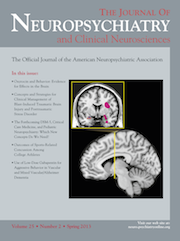Venlafaxine-Associated Hyponatremia Presenting With Catatonia
To the Editor: Catatonia associated with hyponatremia has been described in various clinical situations. Although hyponatremia is described as an uncommon side effect of various antidepressants, in none of the reports was venlafaxine-induced hyponatremia associated with catatonia. We present the case of venlafaxine-induced hyponatremia presenting with catatonia.
Case Report
“Mrs. A,” 59-year-old woman diagnosed with hypertension, presented to the inpatient unit with recurrent depressive disorder, with a current episode of severe depression without psychotic symptoms. Treatment history revealed that she had received tricyclic antidepressants and selective serotonin reuptake inhibitors and had had breakthrough episodes. Her routine investigations, including thyroid function test, did not reveal any abnormality. She was started on venlafaxine 37.5 mg/day, along with alprazolam 0.5 mg bid, enalapril 5 mg/day, and amlodipine 5 mg/day. She tolerated venlafaxine well, and gradually it was increased to 150 mg/day. With this dose, by 2 weeks, she showed partial improvement in her depressive symptoms. After this, the venlafaxine dose was increased to 187.5 mg/day. Within 24 hours of the increase in dose, she developed catatonic signs in the form of immobility, withdrawal, rigidity, negativism, mutism, and posturing. There was no associated history of fever or any other signs and symptoms suggestive of infection. Repeat routine investigations did not reveal any abnormality except low serum sodium levels (127 mEq/L; previous level, on venlafaxine 150 mg/day: 144 mEq/L). Symptoms of catatonia responded transiently to injected lorazepam 2 mg–4 mg. Hyponatremia was corrected with fluid restriction and normal saline, and, over the next 1 week, her catatonic symptoms improved. As she showed improvement, was found to have features of delirium, which was treated with olanzapine. After about 3 weeks of resolution of hyponatremia, her depressive and anxiety symptoms reemerged, for which she was started on milnacipran and pregabalin, with which she achieved symptom remission in 6 weeks. Repeated evaluation did not reveal show signs of hyponatremia.
Discussion
There are very few studies and a handful of case reports presenting data on hyponatremia with venlafaxine. Most of this literature is limited to elderly patients. Studies that have evaluated the incidence and prevalence of hyponatremia in elderly patients receiving venlafaxine reported an incidence rate 17.2%1 and prevalence rate of 71.4%.2
There are eight case reports of hyponatremia associated with venlafaxine.3–10 Most of these reports have described patients ≥75 years of age, female patients, who were receiving concomitant medications. However, in none of these case reports did the clinical picture include development of catatonia.
This index case is unique, as the patient developed features of both catatonia and delirium that temporally correlated with development of hyponatremia after increase in the dosage of venlafaxine. The catatonic symptoms improved after the correction of hyponatremia. However, delirium required treatment with olanzapine.
This case reflects the finding that venlafaxine can lead to development of hyponatremia in an adult population, too, especially in higher doses, and this may present as catatonia and delirium. It is important that clinicians are aware of this rare side effect and monitor serum electrolytes, especially while using higher doses of venlafaxine.
1 : Venlafaxine hyponatraemia: incidence, mechanism, and management. Aust N Z J Psychiatry 2007; 41:411–418Crossref, Medline, Google Scholar
2 : Hyponatraemia in elderly psychiatric patients treated with selective serotonin reuptake inhibitors and venlafaxine: a retrospective controlled study in an inpatient unit. Int J Geriatr Psychiatry 2002; 17:231–237Crossref, Medline, Google Scholar
3 . Venlafaxine-induced hyponatremia. J Clin Psychopharmacol 1997; 17:223–225Google Scholar
4 : Reversible hyponatremia and venlafaxine. Psychosomatics 2005; 46:495–496Crossref, Medline, Google Scholar
5 . Hyponatremia with venlafaxine. Ann Pharmacother 1998; 32:49–51Google Scholar
6 , et al: Venlafaxine-induced reset osmostat syndrome: case of a 79-year-old depressed woman. J Geriatr Psychiatry Neurol 1997; 10:75–78Google Scholar
7 , et al: Syndrome of inappropriate ADH secretion attributed to the serotonin re-uptake inhibitors venlafaxine and paroxetine. Neth J Med 1997; 50:243–245Google Scholar
8 : [Syndrome of inappropriate antidiuretic hormone secretion in the course of treatment with venlafaxine: case report]. Psychiatr Pol 2011; 45:933–939Medline, Google Scholar
9 : Syndrome of inappropriate secretion of antidiuretic hormone due to citalopram and venlafaxine. Gen Hosp Psychiatry 2007; 29:81–84Crossref, Medline, Google Scholar
10 : A case of recurrent hyponatremia induced by venlafaxine. J Clin Psychopharmacol 2006; 26:439Crossref, Medline, Google Scholar



